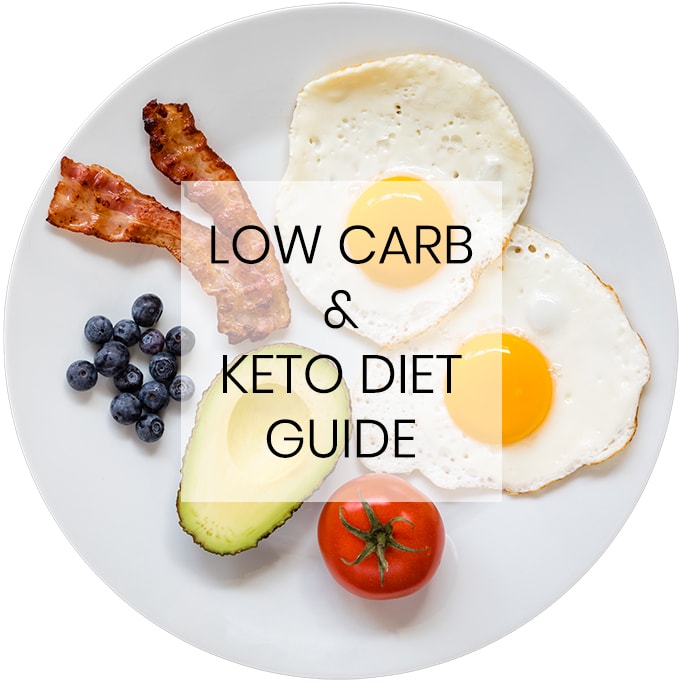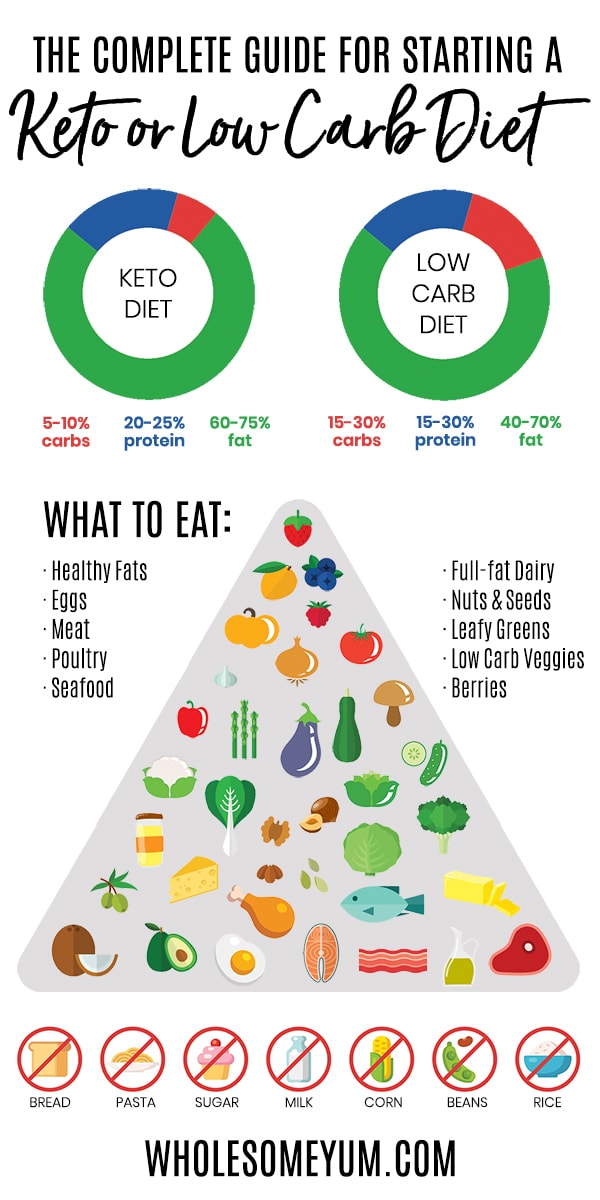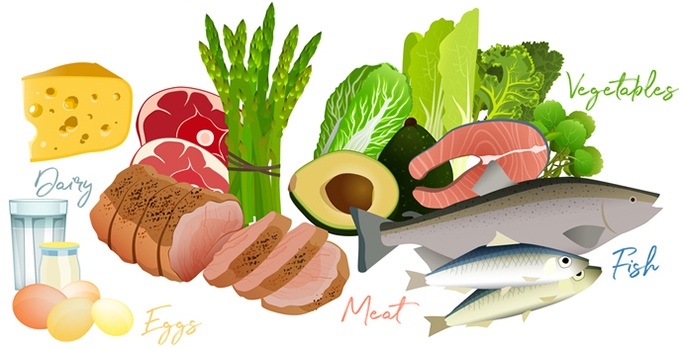A super EASY guide for how to start a keto diet or how to start a low carb diet. Includes basics of the keto diet plan, a low carb food list, and delicious keto & low carb recipes!

Welcome to the Ultimate Guide to a Low Carb & Keto Diet Plan! If you are new to low carb or keto diets, you’ve come to the right place. This guide will show you everything you need to know about how to start a low carb diet, or how to start a keto diet
Read from start to finish if you’re just starting out, or use these links to jump to the area you are interested in:
- What is a low carb diet plan?
- What is the keto diet plan?
- How to start a keto diet or low carb diet
- Low carb & keto macro calculator
- Support for your keto diet plan
- What to eat on a keto diet or low carb diet
- Low carb & keto diet recipes
- Weekly low carb & keto diet meal plan
WHAT IS A LOW CARB DIET PLAN?
A low carb diet plan is a way of eating that is high in fat, moderate in protein and low in carbohydrates. It ends the rollercoaster of blood sugar spikes and crashes, allowing the body to burn fat.
There are different variations of low carb, and the keto diet is a special type of low carb with added characteristics. The number of carbohydrates will vary depending on your insulin tolerance and activity level, but on average, these are the common numbers of carbs:
- Keto diet – Under 20g net carbs per day (sometimes under 25g or 30g works)
- Low carb diet – Under 50g net carbs per day
- Moderate low carb diet – Under 100g net carbs per day
Some people opt to count carbs diligently and some choose to simply focus on eat low carb/keto foods.
WHAT ARE NET CARBS?
Net carbs are simply total carbs minus fiber and non-digestible sugar alcohols, like erythritol. (This doesn’t apply to high glycemic sugar alcohols, like maltitol.) We don’t have to count fiber and certain sugar alcohols in net carbs, because they either don’t get broken down by our bodies, are not absorbed, or are absorbed but not metabolized.
Some people on a keto or low carb diet choose to count total carbs instead of net carbs. This makes it more difficult to fit in more leafy greens and low carb vegetables (which are filled with fiber), so you should only try that if you don’t get results with a net carb method. And, start with reducing sugar alcohols and low carb treats before deciding to do a “total carbs” method.
BENEFITS OF A LOW CARB OR KETO DIET
Low carb diets have numerous benefits, including:
- Weight loss
- Stable mood & energy levels
- Blood sugar control
- Reduced cravings & appetite
- Lower blood pressure
- Higher good cholesterol
- Skin improvements
- Digestive support
- Even possibly increased the lifespan
WHAT IS THE KETO DIET PLAN?
The ketogenic diet, or keto diet plan, is a specific type of low carb diet that is focused on a specific ratio of macronutrients, or macros, with a goal of reaching a state called ketosis.
Macronutrients are fat, protein, and carbohydrates. The ketogenic diet is generally 70% fat, 25% protein and 5% carbohydrates.
WHAT IS KETOSIS?
Ketosis is a metabolic state in which the body burns fat for fuel instead of carbohydrates. It’s very effective for weight loss, energy and mental clarity.
Ketosis is the primary goal of the keto diet plan. We achieve it by severely limiting carbohydrate intake, not calories, but calories are often restricted as a byproduct. In the absence of carbs, the body switches to burning fat for fuel.
Signs of ketosis include increased energy and focus, decreased appetite, and changes in smell of breath or urine. You can test yourself for ketosis using ketone test strips (use code WHOLESOMEYUM for 20% off!), or a blood monitor if you want to be super accurate (not usually necessary).
It usually takes about 3 days after starting a ketogenic diet to enter ketosis, but a few weeks before you are “fat adapted” and burn fat efficiently.
The keto diet plan has the same benefits as low carb diets in general (above), but they are usually amplified. In particular, the weight loss results, mental focus, and energy levels on a keto diet can be incredible.

HOW TO START A KETO DIET OR LOW CARB DIET
If you want to start a keto diet or low carb diet, it can be intimidating. I get it! I’ve been doing this for almost a decade (and it goes to show this is a sustainable lifestyle!), but it wasn’t always easy.
We all have to start somewhere. Just start – you got this!
Whether you’re looking for how to start a keto diet or how to start a low carb diet, there are lots of similarities. I’ll break it down for you to make it as easy as possible…
EASY STEPS FOR HOW TO START A KETO DIET OR LOW CARB DIET
The main point to start a keto diet plan or low carb diet is this:
RESTRICT CARBOHYDRATES. This is the most important! Restrict to less than 20g net carbs per day for a keto diet (some people can get away with under 30g). For a low carb diet, aim for under 50g net carbs per day, though some variations limit to somewhere between 50-100g per day (mostly if you are more active).
Get the carb limit down and you’re most of the way there! But to ensure your success, here are some additional tips for getting started on a keto diet or low carb diet:
- Limit protein intake. A keto diet or low carb diet is not a high protein diet! Low carb is generally higher in protein than keto, but be careful with both. High protein diets can stress the kidneys, and besides, excess protein converts to glucose. Make your protein intake a goal to meet each day, but more than that is not better.
- Use fat as a lever. We’ve been taught to fear fat, but don’t! Both keto and low carb are high-fat diets. Fat is our source of energy as well as satiety. The key to understanding, though, is that fat is a lever on a low carb or keto diet. Carbs and protein stay constant, and fat is the one you increase or decrease (push the lever up or down) to gain or lose weight, respectively. So if your goal is weight loss, eat enough fat to be satisfied, but there’s no need to “get your fats in” once you’re satisfied.
- Drink lots of water. This is especially crucial on a low carb or keto diet. Why? When you eat carbohydrates, your body stores the extra as glycogen in the liver, where they are bound to water molecules. Eating low carb depletes this glycogen, which allows you to burn fat – but it also means you are storing less water, making it easier to get dehydrated. Instead of the traditional recommendation of 8 cups of water per day, aim for 16 cups when following a low carb lifestyle.
- Keep up electrolytes. The major electrolytes in our bodies are sodium, potassium and magnesium. Because a low carb diet (especially a keto diet!) reduces the amount of water you store, this can flush out electrolytes and make you feel sick (called “keto flu”). This is temporary, but you can avoid or eliminate it by salting your food liberally, drinking broth (especially bone broth), and eating pickled vegetables. Some people also choose to take supplements for electrolytes, but it’s best to first consult a doctor that understands and supports keto/low carb lifestyles.
- Eat only when you are hungry. Get out of the mindset that you need to eat 4-6 meals per day or constantly snack. Eating too frequently on a keto or low carb diet is not necessary, and can affect weight loss. Eat when you’re hungry, but if you aren’t, don’t. Eating fewer carbs will make this much easier, as it naturally suppresses appetite.
- Focus on whole foods. Although eating natural or whole foods is technically not 100% required to restrict carbohydrates, eating processed foods will not help you get rid of cravings or be good for your body. Check the section below for more on what low carb foods are best.
- Exercise. This is not required for a low carb diet, but recommended. You’ll feel better, improve your health, and if your goal is weight loss, it will happen faster!
LOW CARB & KETO MACRO CALCULATOR
The above list will give you the basics for how to start a keto diet plan or a low carb diet plan.
But, if you really want to be sure that you are eating the right amounts, you need a low carb or keto macro calculator. Most calculators work for just one or the other, but Wholesome Yum has one that will do it for each diet type!
As a general guideline, here are the macro percentages for a low carb diet plan:
- Fat: 40% to 70%
- Protein: 20% to 25%
- Net carbs: 15% to 30%
… and for a keto diet plan:
- Fat: 60% to 75%
- Protein: 15% to 30%
- Net carbs: 5% to 10%
As you can see, these can vary. Our macro calculator tailors recommendations for you specifically!
CLICK HERE TO CALCULATE YOUR MACROS!
SUPPORT FOR YOUR KETO DIET PLAN
Trust me when I say it gets easier with time – and I’m here to help you every step of the way.
First, the Wholesome Yum Weekly Low Carb & Keto Meal Plan will do a lot of the work for you! Every week, you’ll get a custom meal plan with macros, recipes, shopping lists, time-saving tips, meal prep and more..
And because I know you’re going to love them, you can try the 100% free with no commitment. 🙂

WHAT TO EAT ON A KETO DIET OR LOW CARB DIET
One of the most common questions I get is, “what to eat on a keto diet?” or “what to eat on a low carb diet?” Fortunately, with the right resources, this is one of the easiest questions to answer.
In fact, the keto diet (and low carb diet) is probably the most flexible, sustainable eating lifestyle out there. You don’t have to feel deprived, bored or restricted. And, it doesn’t need to be complicated.
Let’s start with foods to get rid of…
FOODS TO AVOID ON A LOW CARB OR KETO DIET
Avoiding carbohydrates is probably the biggest adjustments for people starting a keto diet or low carb diet. Many of us were used to consuming carbs at every meal. Below is a list of foods to avoid on a keto or low carb diet:
- Grains – including wheat, bread, pasta, rice, oats, cereal, corn, etc.
- Sugar – including table sugar, candy, pastries, cakes, ice cream, chocolate, soda, juice, honey, maple syrup, etc.
- Starchy vegetables – including potatoes, sweet potatoes, parsnips, etc.
- Legumes – including beans, lentils, chickpeas, etc. (Peanuts are an exception in moderation.)
- High-sugar fruits – including bananas, pineapple, oranges, apples, grapes, etc.
- Low-fat dairy & milk – including all cow’s milk (except heavy cream is fine), low-fat cheese, etc.
- Seed & vegetable oils – especially margarine, canola oil, corn oil, grapeseed oil and soybean oil
- Processed “low carb” foods – this depends on ingredients, so read labels for hidden sugar, starch, and artificial ingredients
Get these out of your house if you can! If you have family members that are not on board, at least store these in a separate area from other foods to reduce temptation.
Also, always, always check labels for any food that has one. Avoid anything that has added sugar or starch as an ingredient, watching for different names like dextrose, maltodextrin, maple syrup, honey, corn syrup, cornstarch, potato flakes, etc. Sometimes you’ll be surprised where you might find added sugars.
Now that you know what to avoid, here is a basic list of what to eat on a keto diet or low carb diet instead…
THE BEST FOODS FOR A LOW CARB OR KETO DIET
This simple list summarizes what to eat on a low carb diet. And, what to eat on a keto diet is basically the same:
- Healthy fats like avocado oil, butter, and coconut oil
- Leafy greens like lettuce, spinach, and kale
- Low carb vegetables that grow above ground, like zucchini, cauliflower, and asparagus
- Meat like beef and pork
- Poultry like chicken and turkey
- Seafood like fish and shellfish
- Full-fat dairy like cheese and heavy cream
- Eggs
- Sugar-free beverages like water, coffee, and tea
- Herbs & spices like basil, dill, and cinnamon
- Low carb condiments like mayo, hot sauce, and mustard
You can also enjoy these on a low carb keto diet in moderation:
- Low carb fruit like avocados (the fruit exception that doesn’t need to be in moderation), raspberries and coconuts
- Nuts & seeds like almonds, macadamia nuts, and sunflower seeds
- Sugar-free sweeteners like erythritol, monk fruit, and stevia
- Low carb flours like almond flour, coconut flour, and flaxseed meal
The main difference between the low carb and keto diet is the macronutrient profile, but the types of foods you eat are mostly the same.
These are the basics, and it’s best to start simple – meat, eggs, fats, and veggies primarily. Once you have it down, you can experiment with extras like low carb/keto desserts or more advanced recipes, but it’s not necessary.
Now, let’s delve deeper into a specific list of low carb & keto foods you can eat!
LOW CARB & KETO DIET GROCERY LIST
The list above should give you an idea of the best and worst foods for a low carb diet. But if you’re starting out, it’s a good idea to know exactly what is included.
I have you covered:
- Start with the complete low carb & keto food list! It includes everything you can and can’t eat on the keto diet or low carb diet, and lists the counts of both total carbs and net carbs, too. In fact, you can basically use it as a keto diet grocery list.
- Stock your pantry with the keto low carb shopping list for your pantry.
- Get discounts on keto low carb products here – exclusive for Wholesome Yum readers!
- Check out the keto low carb sweetener guide and calculator to help you choose the best ones and convert from one sweetener to another. You may or may not want to start with sweeteners right away, but it’s there when you’re ready.
LOW CARB & KETO DIET RECIPESIf you are looking for low carb recipes and keto diet recipes, you’ve come to the right place! Every single recipe on Wholesome Yum is low carb and keto-friendly. And, each has 10 ingredients or less, because I’m on a mission to show you that keto and low carb recipes don’t have to be difficult, time-consuming, or taste like “diet food”. I love sharing just how delicious and easy keto/low carb can be! To get you started, here are a few of the most popular low carb keto recipes:- Fathead pizza crust
- Healthy taco salad
- Keto chocolate fat bombs
- Broccoli cheese soup
- Low carb breading more low carb & keto recipes in the low carb recipe index. WEEKLY LOW CARB & KETO DIET MEAL PLANReady to make your Low Carb or Keto Diet EASY?? The Wholesome Yum Weekly Low Carb Keto Meal Plan is here! If you want effortless meal planning that saves you time and helps you succeed on a low carb or keto diet, these are for you. And best of all, you can able to TRY THE KETO MEAL PLAN FREE! Click below for more info about the low carb & keto meal plan.







